 |
July 12, 2007
| Heat Shields |
![]()
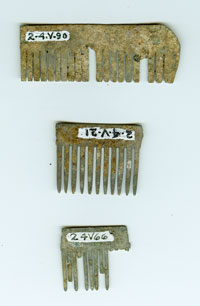 n
the course of TIGHAR’s eighteen-year (and counting) investigation
of the Earhart disappearance and our eight (so far) archaeological expeditions
to Nikumaroro, we have recovered hundreds of artifacts. Many are small items
collected primarily for the purpose of establishing context so that we know
what sorts of objects are “normal” debris from the years the island
was inhabited (1939 to 1963). Some in this category were clearly once part
of an airplane. We have, for example, recovered several small combs fashioned
from aircraft aluminum. These were popular items throughout the region in the
years after WWII, as were fishing lures and decorative inlays for wood carvings
made by cutting sheet aluminum into small pieces. Because the composition of
aircraft aluminum was the same before, during and after the war, these small
artifacts are of little help except in documenting that the people who lived
on Nikumaroro made use of sheet aluminum when they could get it, and that they
did so by cutting it up. All of the airplane-related artifacts were found in
formerly inhabited areas.
n
the course of TIGHAR’s eighteen-year (and counting) investigation
of the Earhart disappearance and our eight (so far) archaeological expeditions
to Nikumaroro, we have recovered hundreds of artifacts. Many are small items
collected primarily for the purpose of establishing context so that we know
what sorts of objects are “normal” debris from the years the island
was inhabited (1939 to 1963). Some in this category were clearly once part
of an airplane. We have, for example, recovered several small combs fashioned
from aircraft aluminum. These were popular items throughout the region in the
years after WWII, as were fishing lures and decorative inlays for wood carvings
made by cutting sheet aluminum into small pieces. Because the composition of
aircraft aluminum was the same before, during and after the war, these small
artifacts are of little help except in documenting that the people who lived
on Nikumaroro made use of sheet aluminum when they could get it, and that they
did so by cutting it up. All of the airplane-related artifacts were found in
formerly inhabited areas.
A few larger scraps of aircraft aluminum have been somewhat more informative. We’ve been able to match four artifacts to a particular aircraft type via either a surviving part number or a distinctive rivet pattern. In each case, the piece came from a B-24. The only aircraft that visited Nikumaroro during the war were PBYs bringing mail and perishable supplies to the Coat Guard Loran station. None was lost or even damaged in those operations but on July 19, 1944, at the big U.S. base on Canton Island two hundred miles away, a Liberator crashed on the reef shortly after takeoff and came to rest in 30 feet of water. The bodies of the five crewmen were recovered but navy divers judged the wreck too dangerous to salvage. It seems reasonable to speculate that, over the years, as the B-24 wreckage began to break up in the surf, pieces of aluminum washed ashore. During the 1950s, people from Nikumaroro found employment on Canton Island, which had become an important refueling stop for trans-pacific airline traffic. It’s not hard to imagine them bringing useful bits of wreckage home to Nikumaroro.
On December 17, 1943 an Army C-47 crashed and burned on Sydney Island some two hundred miles east of Nikumaroro. Although pieces of the wreckage were put to use by the local population, and although people from Sydney are known to have settled on Nikumaroro after the war, no debris identifiable as having come from a C-47 has turned up on the island. We don’t know why. Sydney had an established settlement and it may be that the airplane wreckage was considered to be a local asset that should not be exported. Canton, by contrast, was no one’s home island. It was just a place to work. Useful debris found there may have been unencumbered by issues of ownership.
A few pieces of aircraft debris found on Nikumaroro seem to offer the possibility that they might be from the Earhart Electra. TIGHAR Artifact 2-3-V-2 is a fragment of Plexiglas that matches the thickness, color and curvature of Lockheed Part Number 40552, the cabin windows of the Lockheed Model 10 (see TIGHAR Tracks Vol. 12, No. 1, March 31, 1996). TIGHAR Artifact 2-2-V-1 is a section of .032 aircraft skin that might have been part a repaired section of Earhart’s airplane (see TIGHAR Tracks Vol. 8, No. 3, April 30, 1992 and TIGHAR Tracks Vol. 9, No. 1, January 15, 1993). Coincidence and speculation, however, do not a smoking gun make.
Another group of aviation artifacts recovered from Nikumaroro appear to have more potential. Like the others, they were found in the abandoned village and are clearly scraps left over from local use of salvaged airplane parts. They represent at least three and probably four separate, and fairly complex, structures which, in their original form, were virtually identical. No part numbers appear anywhere on the artifacts, suggesting that they are civilian rather than military in origin. The big questions, of course, are what are they for and where did they come from?
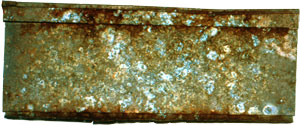
![]() he first, and most complete, example was recovered during our very first expedition
to Nikumaroro in 1989. We discovered Artifact 2-1-V-18 lying on the ground
near the remains of the village carpenter shop. All we knew at the time was
that it was an odd-looking riveted aluminum structure with a fragment of some
kind of insulating material stuck to one side.
he first, and most complete, example was recovered during our very first expedition
to Nikumaroro in 1989. We discovered Artifact 2-1-V-18 lying on the ground
near the remains of the village carpenter shop. All we knew at the time was
that it was an odd-looking riveted aluminum structure with a fragment of some
kind of insulating material stuck to one side.
Metallurgists at the National Transportation Safety Board (NTSB) laboratories in Washington, DC identified the alloys but couldn’t tell us what the structure was used for. They did, however, manage to lose the insulation fragment. Seniors technicians at a shop that installs business aircraft interiors later identified the artifact as a “dado” – a panel, often insulated, which covers and protects the juncture of the aircraft’s cabin flooring and the fabric-covered interior wall (see TIGHAR Tracks, Vol. 11, No. 3, September 11, 1995). Military aircraft do not normally feature dados. The only civilian aircraft known to have been wrecked on Canton Island was an FAA Constellation that crashed and burned in 1962. By that time, the settlement on Nikumaroro was already in the process of being abandoned.
With no apparent alternative explanation, we considered whether the dado might have come from the civilian aircraft we suspected had been wrecked on Nikumaroro in 1937 – but did Earhart’s Electra even have dados? We looked closely at all of the available plans and photos but no dados were apparent. The origin of Artifact 2-1-V-18 joined a growing list of unanswered, and perhaps unanswerable, questions about objects we had found on Nikumaroro.
Then, in 2003, TIGHAR’s seventh expedition to Nikumaroro found two more “dados” near where we recovered the first one fourteen years before. These were somewhat longer and in much worse condition than 2-1-V-18 but they were, without question, the same type of component.
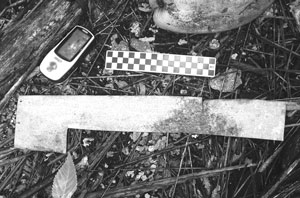 |
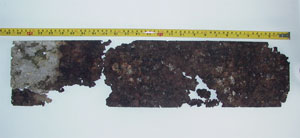 |
Artifact 2-7-V-1 |
Artifact 2-7-V-2 |
A close review of our collection revealed that another piece of aluminum sheet found in the same area in 1989, Artifact 2-1-V-2, matches the alloy type and general dimensions of the “dados.” One unidentified artifact is a curiosity. Four examples of the same unidentified aircraft component in the same location is a red flag that something interesting is going on. It was beginning to look like the area around the old carpenter’s shop on Nikumaroro was dirty with dados. Where had they come from? What were we missing?
Whenever we’re confronted with an apparently unsolvable puzzle, we back up and re-examine the supposed facts of the case. Reviewing our reconstruction of 2-1-V-18, we found a mistake. Rust marks left by “Tinnerman” fasteners showed that two holes we had previously identified as “mounting holes” were, in fact, used for securing the insulation to the face of the dado. It seems like a small detail, but it changed everything. Without mounting holes, there was no way to attach the dado to the cabin wall. The only way to affix the object to anything was via the right angle flange along the bottom. The holes in the flange were not rivet holes but were, instead, meant to accommodate screws or, more probably, nails (as evidenced by pry marks on the underside of the flange).
![]() ur artifacts were starting to look like very strange dados. They were apparently
sections of a cantilevered, insulated wall six and a half inches tall, nailed
to a wooden surface. The Lockheed Electra, and a number of other aircraft,
had wooden floor panels, so the nails were easy to explain, but not attaching
the dado to the fuselage structure made no sense. Such a light-weight, free-standing
wall would be easily damaged. Was this really the way Lockheed installed dados?
Or maybe these weren’t dados at all. Electra passenger cabins were well
insulated to reduce engine noise, but documents show that this feature was
omitted from Earhart’s 10E Special to save weight. If her airplane had
a low insulated wall nailed to the floor in the cabin, what purpose might it
have served? Logically, an insulated barrier would be used to shield something
that shouldn’t get hot from a source a heat. The only sources of heat
in an Electra cabin were the heater ducts that ran along the floor on each
side. Hot air from cuffs around the engine exhaust manifolds flowed through
the ducts to heat the cabin. Earhart’s Electra had the standard heater
ducts but it also had fuel tanks installed in the cabin. Might it have been
necessary to keep direct heat away from the tanks? Might an insulated wall
between the heater ducts and the fuselage tanks have served that purpose? Might
our “dados” be, in fact, be components of a system that was unique
to the Lockheed 10E Special?
ur artifacts were starting to look like very strange dados. They were apparently
sections of a cantilevered, insulated wall six and a half inches tall, nailed
to a wooden surface. The Lockheed Electra, and a number of other aircraft,
had wooden floor panels, so the nails were easy to explain, but not attaching
the dado to the fuselage structure made no sense. Such a light-weight, free-standing
wall would be easily damaged. Was this really the way Lockheed installed dados?
Or maybe these weren’t dados at all. Electra passenger cabins were well
insulated to reduce engine noise, but documents show that this feature was
omitted from Earhart’s 10E Special to save weight. If her airplane had
a low insulated wall nailed to the floor in the cabin, what purpose might it
have served? Logically, an insulated barrier would be used to shield something
that shouldn’t get hot from a source a heat. The only sources of heat
in an Electra cabin were the heater ducts that ran along the floor on each
side. Hot air from cuffs around the engine exhaust manifolds flowed through
the ducts to heat the cabin. Earhart’s Electra had the standard heater
ducts but it also had fuel tanks installed in the cabin. Might it have been
necessary to keep direct heat away from the tanks? Might an insulated wall
between the heater ducts and the fuselage tanks have served that purpose? Might
our “dados” be, in fact, be components of a system that was unique
to the Lockheed 10E Special?
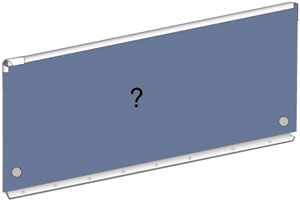 |
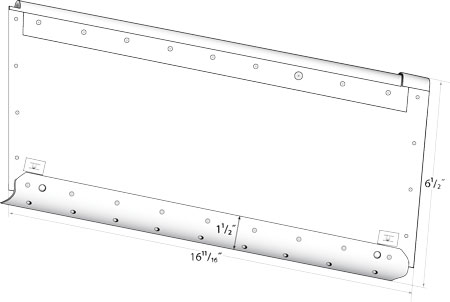 |
Front |
Back |
These were interesting hypotheses but an untested hypothesis is just speculation. We needed better information about how Lockheed Electra cabins were put together. Restored aircraft might or might not be correct. We needed the most original Electra we could find. That turned out to be a mostly intact, rather famous, and all but inaccessible wreck that had gone down on January 5, 1943 in what is today Alaska’s Misty Fjords Wilderness Area. With the generous help of the U.S. Forest Service, an experienced and determined TIGHAR team was able to reach the site in the summer of 2004. Their efforts were rewarded with more answers than we anticipated. (See TIGHAR Tracks Vol. 20, No. 3, December 2004.)
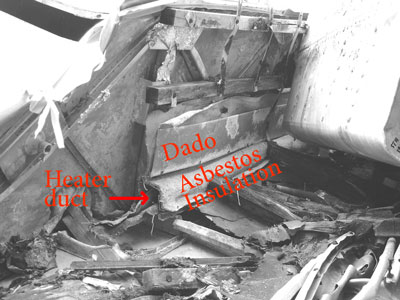 The Electra’s cabin did feature dados, but they were nothing like the
structures we found on Nikumaroro – much simpler, not insulated, not
attached to the flooring, and fastened to the fuselage with screws. A careful
examination of the wreck in Alaska revealed that this particular Electra had
been modified to carry a small auxiliary fuel tank in the cabin. Where the
tank was close to the cabin wall, and only in that area, the heater duct was
wrapped in heavy asbestos matting. This was unexpected, but welcome, confirmation
that fuel tanks installed in an Electra cabin had to be insulated from the
heater ducts.
The Electra’s cabin did feature dados, but they were nothing like the
structures we found on Nikumaroro – much simpler, not insulated, not
attached to the flooring, and fastened to the fuselage with screws. A careful
examination of the wreck in Alaska revealed that this particular Electra had
been modified to carry a small auxiliary fuel tank in the cabin. Where the
tank was close to the cabin wall, and only in that area, the heater duct was
wrapped in heavy asbestos matting. This was unexpected, but welcome, confirmation
that fuel tanks installed in an Electra cabin had to be insulated from the
heater ducts.
We now felt confident that our original theory that the objects found on Nikumaroro were dados was incorrect. The new hypothesis that they were heat shields was looking better. A photo of NR16020 under construction shows the heater ducts in place but no sign of asbestos matting. The matting might have been an easy way to insulate one small tank, but the material is quite heavy. The six fuselage tanks in Earhart’s 10E Special occupied the entire forward section of the cabin. The structures we found on Nikumaroro would be a more involved but much lighter solution to the problem.
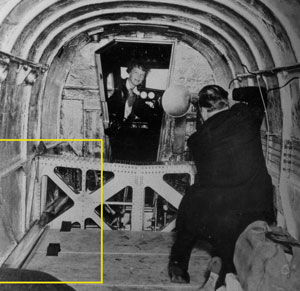 |
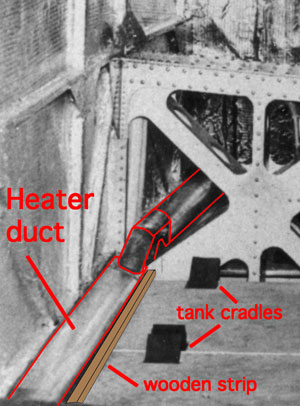 |
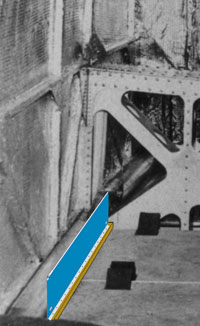 |
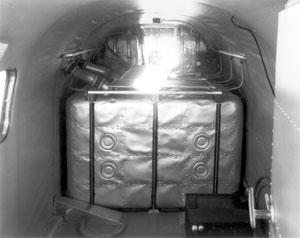 |
![]() he next step, of course, is to look for evidence that such highly specialized
structures were installed in NR16020. If we can confirm that with solid primary
source documentation – engineering drawings, descriptions, or photographs – our
former dados, now putative heat shields, will become smoking guns. We’re
not there yet, but we have found what appears to be another clue that we’re
on the right track.
he next step, of course, is to look for evidence that such highly specialized
structures were installed in NR16020. If we can confirm that with solid primary
source documentation – engineering drawings, descriptions, or photographs – our
former dados, now putative heat shields, will become smoking guns. We’re
not there yet, but we have found what appears to be another clue that we’re
on the right track.
The same photo that shows the heater ducts, but no asbestos, in place just before the fuselage tanks were installed, also shows something on the floor beside the ducts. Running parallel and immediately adjacent to the heater duct on the left side of the cabin is what appears to be a piece of wooden molding perhaps one inch square in cross-section. Its precise placement suggests that it is installed rather than just tossed down. What is it for? Other Electras don’t have anything there.
The tank in the Alaska wreck was mounted on a wooden frame, but Earhart’s tanks seem to have rested directly on the floor, held in place by cradles attached to the flooring and padded metal straps anchored to the fuselage structure. The wooden strip could be to brace the fuselage tanks against side-to-side shifting (the heater ducts are easily dented), but the photo shows no provision for insulating the tanks from the heater ducts. Was the photo taken just before heat shields were nailed to the wooden strip? The Electra’s flooring was divided into panels that could be removed to permit access to wiring and accessories, such as the flap motor, in the belly. Attaching the insulating barrier to a wooden strip would be better than nailing it directly to the floor. That way the whole assembly could be easily removed as one piece if one or more floor panels needed to be taken up.
Unfortunately, once the tanks were installed, photos can’t show what might be between the tank and the wall. So what’s the next step? After eighteen years of research we feel pretty confidant that we have copies of all of the available photos of the Earhart airplane under construction. The same is true of engineering drawings. Lockheed diagram 42681, dated March 12, 1937, is a schematic of the fuel system for Earhart’s Electra. It’s good documentation of how the plumbing worked but it’s of no help in answering this question. If drawings detailing the installation of the fuselage tanks exist, they have not come to light.
![]() ockheed test flew the airplane as X120260 a few days before delivering it to
Amelia on her birthday, July 24, 1936. Inspection reports show that, during
the test period, the machine featured 13 fuel tanks, 6 in the wings and 7 in
the fuselage, with a combined capacity of 1,198 gallons. There were apparently
some problems with the original fuel system because another inspection by the
Bureau of Air Commerce just a couple weeks later – August 7, 1936 – shows
that all of the fuselage tanks had been removed. Why? Were they experiencing
problems from the heating of the fuselage tanks? Was this when they discovered
the need to insulate the tanks from the heater ducts? It seems like there should
have been Lockheed memoranda discussing whatever problems were encountered
and how they were resolved, but if there were, and if they still exist, they
have not surfaced. The only reference we’ve found is in a letter Earhart’s
husband, George Putnam, wrote to the Bureau of Air Commerce on October 29,
1936. In trying to straighten out a discrepancy in the aircraft’s license,
he wrote, “The tanks were out for a very brief time at the Lockheed plant
for some adjustment.”
ockheed test flew the airplane as X120260 a few days before delivering it to
Amelia on her birthday, July 24, 1936. Inspection reports show that, during
the test period, the machine featured 13 fuel tanks, 6 in the wings and 7 in
the fuselage, with a combined capacity of 1,198 gallons. There were apparently
some problems with the original fuel system because another inspection by the
Bureau of Air Commerce just a couple weeks later – August 7, 1936 – shows
that all of the fuselage tanks had been removed. Why? Were they experiencing
problems from the heating of the fuselage tanks? Was this when they discovered
the need to insulate the tanks from the heater ducts? It seems like there should
have been Lockheed memoranda discussing whatever problems were encountered
and how they were resolved, but if there were, and if they still exist, they
have not surfaced. The only reference we’ve found is in a letter Earhart’s
husband, George Putnam, wrote to the Bureau of Air Commerce on October 29,
1936. In trying to straighten out a discrepancy in the aircraft’s license,
he wrote, “The tanks were out for a very brief time at the Lockheed plant
for some adjustment.”
The next time the Electra was inspected was on November 27, 1936, at which time it featured 6 wing tanks and 6 fuselage tanks with a combined total of 1,151 gallons. Minor changes to the plumbing, but not to the tanks or the total capacity, were recorded on February 6, 1937 and on March 10, 1937. The first world flight attempt began on March 17 and ended three days later with the takeoff accident in Hawaii. The aircraft’s final inspection by the Bureau of Air Commerce was on May 19, 1937, the day repairs were completed at the Lockheed plant in Burbank and the day before Earhart began her second world flight attempt. That inspection report shows no change in the number of fuel tanks or their capacities and makes no mention of any measures taken to insulate the fuselage tanks from the heater ducts. Unless currently unknown documents or photographs turn up, research into how the tanks in NR16020 were shielded seems to have hit a dead end.
![]() hen you hit a dead end, you try an end run. Another possible avenue of research
into this question is the sister ship to Earhart’s Electra, the only
other 10E Special, the “Daily Express.” Although today largely
forgotten, the “Daily Express” is credited with the first commercial,
round-trip crossing of the North Atlantic. The aircraft had been delivered
to millionaire Harold Vanderbilt as a standard 10E on August 26, 1936. On December
10th England’s King Edward VIII abdicated the throne to marry “the
woman I love,” and newspaper magnate William Randolph Hearst let it be
known that he would pay handsomely for timely high-quality photographs of George
VI’s coronation to be held the following May. In response, Wall Street
brokers Ben “Sell ’em short” Smith and Jack Bergen bought
Vanderbilt’s 10E and had Lockheed modify it similarly to Amelia Earhart’s
long-range Electra, although in this case the fuel capacity would total a whopping
1270 gallons. The ship, registered as NR16059, was christened “Daily
Express” after a British newspaper owned by Smith’s friend Lord
Beaverbrook. The name also carried the implication of daily express service
across the Atlantic.
hen you hit a dead end, you try an end run. Another possible avenue of research
into this question is the sister ship to Earhart’s Electra, the only
other 10E Special, the “Daily Express.” Although today largely
forgotten, the “Daily Express” is credited with the first commercial,
round-trip crossing of the North Atlantic. The aircraft had been delivered
to millionaire Harold Vanderbilt as a standard 10E on August 26, 1936. On December
10th England’s King Edward VIII abdicated the throne to marry “the
woman I love,” and newspaper magnate William Randolph Hearst let it be
known that he would pay handsomely for timely high-quality photographs of George
VI’s coronation to be held the following May. In response, Wall Street
brokers Ben “Sell ’em short” Smith and Jack Bergen bought
Vanderbilt’s 10E and had Lockheed modify it similarly to Amelia Earhart’s
long-range Electra, although in this case the fuel capacity would total a whopping
1270 gallons. The ship, registered as NR16059, was christened “Daily
Express” after a British newspaper owned by Smith’s friend Lord
Beaverbrook. The name also carried the implication of daily express service
across the Atlantic.
To fly the airplane, Smith persuaded Eastern Airlines boss Eddie Rickenbacker to loan the services of his star pilot, Henry T. “Dick” Merrill and Jack Lambie.
The story of the Merrill/Lambie nonstop flights to and from England in May 1937 is an epic in its own right, with a number of implications relating to the Earhart/Noonan world flight that left Miami just two weeks later. Our interest for the moment, however, is the very narrow question of whether there exists documentation of how Lockheed addressed the heat shield question in modifying the Daily Express. Perhaps we’ll hit another dead end, but even if we’re lucky enough to find documentation that the Daily Express was equipped with structures just like the ones we’ve found on Nikumaroro, it won’t bestow smoking gun status on our artifacts. Along the way we might also uncover information that disproves our heat shield hypothesis. (We are, by far, the leading debunker of our own theories.) That would be okay too.
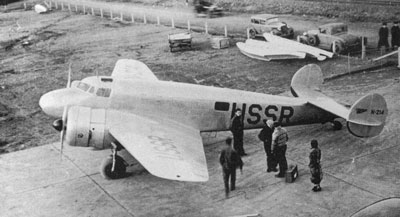 |
After its epic transatlantic flight,
the Daily Express was sold to the Soviet Union and used in the search the
lost transpolar aviator Sigismund Levinevski. The airplane’s ultimate
fate is unknown. |
If anyone has information that might be helpful in this investigation, please
let us know. You can write to executive director Ric Gillespie at
TIGHAR
2366 Hickory Hill Road
Oxford, PA 19363 USA
Or email Ric
